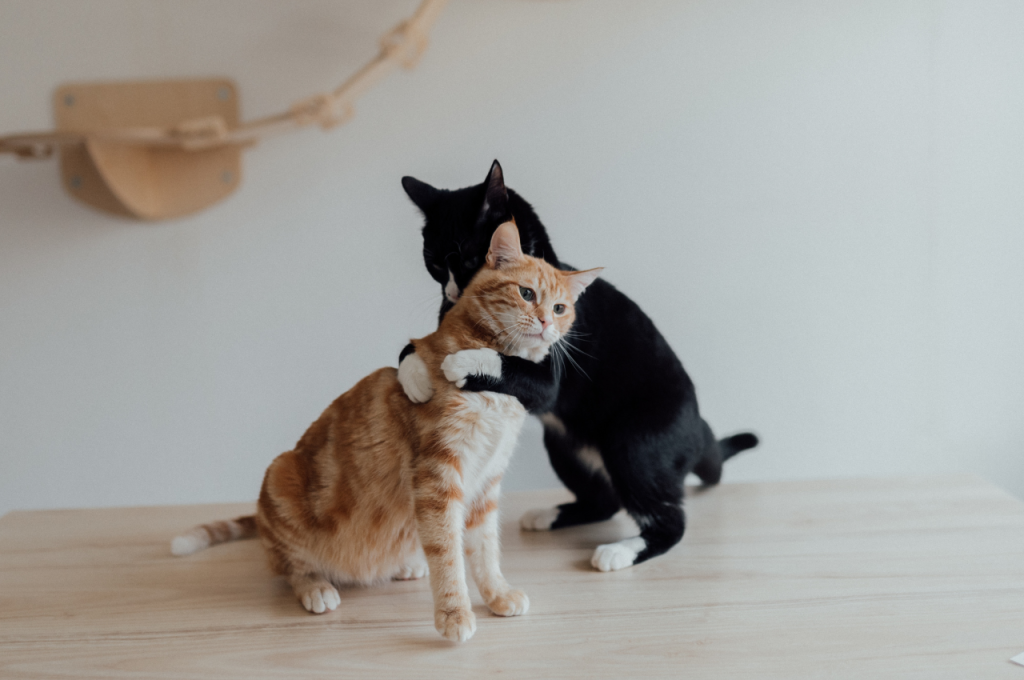To create a safe space for cats, ensure no toxic plants, secure windows, and cozy hiding spots. Creating a safe environment for your feline friend is essential to their well-being and happiness.
By making a few simple adjustments to your home, you can provide a secure space where your cat can thrive. From removing toxic plants and securing windows to providing cozy hiding spots and scratching posts, there are various ways to ensure your cat feels safe and comfortable in their surroundings. In this blog post, we will explore practical tips and ideas to help you create a safe space that meets all of your cat’s needs.
Introduction to Feline Comfort Zones
Feline comfort zones are areas where cats feel safe, secure, and relaxed. These spaces are crucial for a cat’s well-being, as they provide a retreat from stressors like loud noises, unfamiliar people, or other animals. A comfort zone might include a cozy corner, a high perch, or a soft bed, often located in a quiet area of the home. Providing multiple comfort zones helps cats express natural behaviors, such as climbing, hiding, or observing their surroundings. Understanding and creating these zones in your home can greatly enhance your cat’s overall happiness and reduce anxiety, leading to a healthier and more contented pet.

Why Cats Need Their Own Space
Cats are territorial animals that require a designated space where they feel safe and secure. Creating a safe space for your feline friend is essential for their well-being and happiness. Providing a dedicated area helps reduce stress and anxiety, allowing your cat to retreat to a familiar environment when needed.
The Impact of Environment on Cat Behavior
The environment plays a crucial role in shaping a cat’s behavior and overall well-being. A comfortable and secure space can help alleviate behavioral issues such as aggression, excessive grooming, or hiding. By understanding the impact of their environment, cat owners can proactively create a conducive space that promotes positive behavior and mental health for their pets.
Identifying The Perfect Spot
Creating a safe space for your cat starts with identifying the perfect spot in your home. This spot should be a comfortable and secure area where your cat can relax, play, and feel at ease. By understanding the factors to consider, as well as your cat’s preferences and personalities, you can create an ideal environment that meets your feline friend’s needs.
Factors to Consider
When identifying the perfect spot for your cat, consider factors such as accessibility, visibility, and proximity to resources. Cats appreciate having a space that is easily accessible, offers a good vantage point, and is located near food, water, and litter boxes.
Cat Preferences and Personalities
Understanding your cat’s preferences and personalities is crucial in creating a safe space. Some cats may prefer a quiet and secluded area, while others may enjoy being in the midst of household activities. Take into account whether your cat is more introverted or outgoing when determining the ideal location for their safe space.
Elements of a Secure Cat Haven
Cats are known for their independent and curious nature, and it’s important to create a secure environment that meets their natural instincts. By providing specific elements in their living space, you can ensure that your feline friend feels safe and comfortable. Here are the essential components of a secure cat haven:
Cozy Bedding and Rest Areas
Comfortable bedding and designated rest areas are crucial for your cat’s well-being. Provide soft, plush beds and blankets where they can curl up and relax. Incorporate raised platforms and window perches to give them a sense of security while observing their surroundings.
Safe Climbing and Hiding Spots
Cats love to climb and seek out hiding spots. Create a variety of vertical spaces such as cat trees, shelves, and perches for climbing and exploration. Incorporate enclosed hiding spots like cozy caves or partially covered areas to give your cat a sense of security.
The Importance of Cleanliness
Creating a safe space for cats is essential for their health and happiness. One of the most important aspects is cleanliness. Regularly cleaning their litter box, bedding, and food/water bowls can prevent the spread of harmful bacteria and parasites, keeping both you and your feline friend healthy.
Regular Cleaning Routines
Creating a safe space for cats involves establishing regular cleaning routines to maintain a clean and hygienic environment. Start by cleaning litter boxes daily to prevent odors and reduce the risk of infections. Vacuum frequently to remove fur, dust, and allergens that could affect your cat’s health. Clean food and water dishes daily to prevent bacteria buildup, and sanitize bedding and toys weekly. Regular cleaning not only promotes your cat’s physical health but also reduces stress, as cats thrive in clean and orderly surroundings. A clean environment ensures a safe and comfortable space for your cat, encouraging relaxation and promoting overall well-being.
Litter Box Management
Proper management of litter boxes is essential for cat well-being. Regular cleaning routines are crucial for creating a safe space for your feline friends. Cleanliness helps prevent the spread of bacteria and diseases among cats. It is important to establish a consistent cleaning schedule to ensure the environment remains hygienic. When it comes to litter box management, it is essential to regularly scoop out waste and clumps. Change the litter frequently to prevent odors and maintain cleanliness. Place the litter box in a quiet and accessible location for your cat.
Regular Cleaning Routines
- Establish a consistent cleaning schedule
- Prevent the spread of bacteria and diseases
- Maintain a hygienic environment
Litter Box Management
- Regularly scoop out waste and clumps
- Change litter frequently to prevent odors
- Place the litter box in a quiet and accessible location
Interactive and Stimulating Toys
Create a safe space for cats by providing interactive and stimulating toys. These toys help to keep cats engaged and active while also preventing them from getting into dangerous situations. By providing a variety of toys, cats can play and explore in a safe environment.

Interactive and stimulating toys are essential for creating a safe space for cats. These toys provide mental and physical stimulation, which is important for keeping cats happy and healthy. By providing your cat with interactive and stimulating toys, you can help prevent boredom, reduce stress, and promote exercise.
Choosing The Right Toys
When choosing toys for your cat, it’s important to consider their preferences and personality. Some cats prefer toys that they can chase, while others prefer toys that they can bat around. You should also consider your cat’s age and physical abilities. For example, older cats may prefer softer toys that are easier on their teeth and joints.
Rotation Strategy to Maintain Interest
To keep your cat interested in their toys, it’s important to rotate them regularly. This helps prevent boredom and ensures that your cat always has something new to play with. You can create a rotation schedule to help you remember which toys to offer each day. Consider investing in a few new toys every few months to keep your cat’s toy collection fresh and exciting. Just be sure to introduce new toys slowly and supervise your cat during playtime to ensure their safety.
In conclusion, interactive and stimulating toys are essential for creating a safe space for cats. By choosing the right toys and implementing a rotation strategy, you can keep your cat happy, healthy, and entertained.
Stress Reduction Strategies
Implement stress reduction strategies to create a safe space for cats. Provide hiding spots, vertical territory, and calming scents. Use interactive toys and gentle music for relaxation. Cats are sensitive creatures and can become easily stressed in their environment. As a cat owner, it’s essential to create a safe space for your feline friend to minimize their stress levels. Here are some stress reduction strategies you can implement:
Calming Products and Techniques
You can use various calming products and techniques to reduce your cat’s stress levels. Here are some examples:
- Pharmaceuticals: Consult with your veterinarian about prescription medications that can help reduce your cat’s stress levels.
- Pheromones: Synthetic pheromones, such as Feliway, can mimic the natural pheromones that cats produce to feel calm and secure.
- Music: Playing soothing music or white noise can help create a calming environment for your cat.
- Meditation: Practicing meditation and deep breathing exercises can help reduce your stress levels, which can also help calm your cat.
Importance of Routine
Cats thrive on routine, and creating a consistent daily schedule can help reduce their stress levels. Here are some ways to create a routine for your cat:
- Feeding Schedule: Feed your cat at the same time every day.
- Litter Box: Keep the litter box clean and in the same location.
- Playtime: Schedule regular playtime with your cat.
- Sleeping Area: Provide your cat with a cozy sleeping area in a quiet location.
By implementing these stress reduction strategies, you can create a safe space for your cat, which can help reduce their stress levels and improve their overall well-being.
Dealing with Multiple Cats
Living with multiple cats can be rewarding, but it’s essential to establish territories and manage conflicts to create a safe and harmonious environment for your furry companions.
Establishing Territories
- Create separate feeding areas for each cat.
- Provide multiple litter boxes in different locations.
- Offer vertical spaces like cat trees for climbing.
Managing Conflict
- Observe your cats’ body language for signs of tension.
- Intervene with calming techniques like play or treats.
- Provide hiding spots and escape routes for each cat.
Ongoing Observation and Adjustment
Creating a safe space for cats involves ongoing observation and adjustment to meet their needs. Monitor your cat’s behavior to identify any signs of discomfort or anxiety, such as hiding, excessive grooming, or changes in appetite. Make necessary adjustments, like adding more hiding spots, perches, or cozy beds to help them feel secure. Ensure that the space is free from hazards, like toxic plants or small objects they might swallow. Continually assess their environment and modify it as needed to accommodate changes in your cat’s preferences or health, ensuring a safe, comfortable, and nurturing space for them at all times.

Monitoring Cat Behavior
- Observe cats’ reactions to the space.
- Check for signs of stress or discomfort.
- Ensure cats have access to hiding spots.
Making Necessary Changes
- Adjust litter box placement as needed.
- Provide scratching posts for territorial marking.
- Introduce new toys for enrichment.
Conclusion
Creating a safe space for your beloved feline friends is crucial for their well-being. By following these tips, such as providing hiding spots, regular playtime, and a calm environment, you can ensure their safety and happiness. Remember, a safe space not only protects your cat from potential dangers but also fosters their trust and confidence. So, make your home a sanctuary where your cats can thrive and feel secure.
